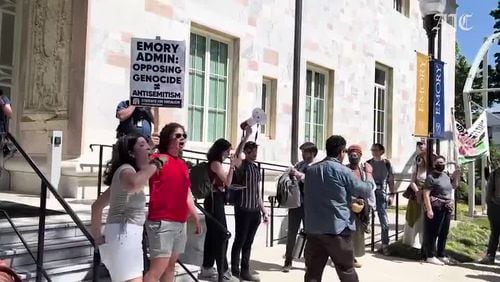Da’Shun Harrison hasn’t decided who he’s voting for in the presidential election.
The politically active Morehouse College student and campus NAACP vice president has closely followed the race and knows the candidates’ platforms. He likes the variety of viewpoints, but isn’t satisfied with any of the candidates — yet.
This election season Harrison, 19, typifies young voters: engaged and informed, and hoping to make an impact on who is elected the country’s next president.
Voters age 18 to 29 have already had impact, with their large turnout giving candidates victories in Iowa and New Hampshire. About 43 percent of youth voters participated in the New Hampshire primary last week, tying the record-breaking turnout of 2008, according to an analysis by Tufts University's Center for Information and Research on Civic Learning and Engagement.
That momentum sets the stage for Tuesday’s visit to Morehouse by Democratic candidate Bernie Sanders, whose courting of the youth vote with ideas like free college has helped fuel the excitement for the race’s oldest candidate. Sanders has doggedly pursued that age group and appears to have more support from young people than any other candidate. Sanders garnered 83 percent of the youth vote in New Hampshire and 84 percent in Iowa in the Democratic races. Donald Trump, the Republican front-runner, received 37 percent of youth vote in the New Hampshire’s GOP primary.
“Young people really like to see the impact of their contribution. We had seen a decline of voter trust over the past three years, and we saw this in turnout and voter surveys,” said Kei Kawashima-Ginsberg, CIRCLE’s director.
A historic high youth turnout for Barack Obama’s presidential election in 2008 was followed by less than stellar voting rates for this group two years later. Young voter turnout in midterm elections declined from 23.5 percent in 2006, to 20.4 percent in 2010 and 13 percent in 2014, according to CIRCLE data.
“This year there seems to be a tidal change in that young people seem to think they can have (an impact) on things going on in the country,” Kawashima-Ginsberg said.
Issues are key
Driving young voters to the polls are concerns like the economy and their ability to get jobs after graduation.
“I know a lot of students are paying attention to the candidates’ positions on how they’re going to ensure our generation has the resources necessary to be competitive in the job market,” said Tate Mitchell, executive director of the University of Georgia College Republicans. Some young Democrats at UGA last week cited income inequality, access to education, campaign finance reform and environmental action as key issues for their political involvement.
"Change happens from the bottom up," said Nick Langley, founder and president of Panthers for Bernie, a Georgia State University student group that endorses Sanders. "It requires millions of people to become active and engaged to put pressure on those in power and those making the decisions."
Some young voters are willing to protest for the changes they want. Before student protesters started disrupting campaign events — like Hillary Clinton's Clark Atlanta University visit in October — the candidates weren't talking about issues like police brutality and racial injustice, said Josh Niemtzow, 20, a member of Emory University Students for Hillary.
Since the protests that roiled campuses in the summer and fall, young voters have continued their activism, filled arenas supporting candidates, volunteered with campaigns and chronicled it all on social media.
Olivia Buckner was one of 24 Mercer University students who traveled to Iowa or New Hampshire as part of a special topics course on the presidential primary. Half campaigned for the Democratic candidates and the other 12 worked with Republicans Marco Rubio, John Kasich and Rand Paul.
Buckner, Mercer's sophomore class president, was initially drawn to Clinton because she was intrigued by the female presidential candidate. "I've always had a strong female political figure in my life," Buckner said, referring to her state representative mother, Debbie Buckner, D - Junction City.
During her week in New Hampshire, Buckner spent most of her time in Clinton's phone bank, calling voters. She also waited in line three hours to attend a Clinton rally, and nabbed a selfie with the candidate afterward. She immediately texted the photo to both her parents back home in Georgia.
An "untapped market"
Getting involved matters more to some student groups than party affiliation. Campus-wide initiatives at Georgia State have helped get 200 students registered to vote; a similar initiative at UGA has gotten 1,300 students registered.
A lot of young voters feel that they are being taken for granted by the established politicians of either party, and don't like that, said Obie Clayton a sociology professor at Clark Atlanta University, who studies youth voting.
"The younger group seems more concerned about the messages as opposed to the lineage," Clayton said.
So they attend Sanders' "Feel the Bern" rallies to hear more about his socialist ideas, and listen to Trump discuss his ideas for making America great again.
"We're an untapped market. We consistently have the lowest voter turnout of any age group," said Niemtzow. "But it's amazing how in this race you can get almost anyone to have a conversation about politics. We definitely have a chance to make our voices heard."
About the Author






